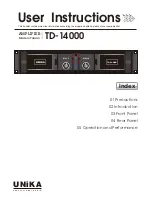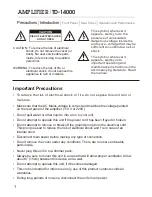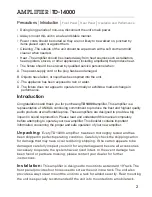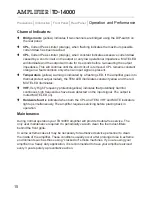
8
Precautions Introduction Front Panel Rear Panel
Operation and Performance
Binding Post(BP)Output connectors
Figure
8
Binding Post outputs
!
Refer to the instructions in this
section if your amplifier I equipped
with Binding Post output connectors.
Connect the positive (+) loudspeaker
cable to the positive (+) red
terminals. Connect the negative (-)
loud speaker cable, to the negative (-
) black terminals. For bridge mode,
connect the positive (+) terminal on
Channel B to the negative (-)
loudspeaker cable.
The outputs on The TD-14000 amplifiers produce high voltage. Do not connect or
disconnect the loudspeaker cables while the mains power is on. Never operate
the amplifier with any portion of bare loudspeaker wore exposed.
NOTE
NOTE
Never connect an output terminal to ground, or to any other input or output.
Observe relative loudspeaker polarity: loudspeakers connected in reverse
polarity will exhibit degraded performance, particularly in bass frequence, and
may be damaged as a consequence.
Use a high-quality stranded loudspeaker cable, and keep cable run as short as
possible.
Output bridge mode
It is possible to bridge channels in two-channel versions. When bridged, the input source must
be connected to input (A+B) respectively. Output speaker cables must be connected to the
plus pole on channel A and the minus pole on B.
Most power amplifier designs, when bridged, automatically introduce a +6 dB input gain boost
which can lead the user to conclude that power” when in bridge mode. This is clearly not the
case, as the gain boost artificially enhances perceived power at the cost of headroom. The
TD14000 amplifier work on globally set constant gain, and automatically compensate the input
gain by -6 dB. For example, if the amplifier is configured in a three-channel mode, then the
selected gain is maintained from input to output on all channels.
AMPLIFIER
TD
-
14000
Summary of Contents for TD-14000
Page 17: ...16 NOTE...




































